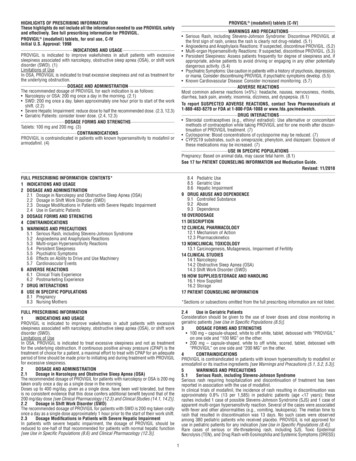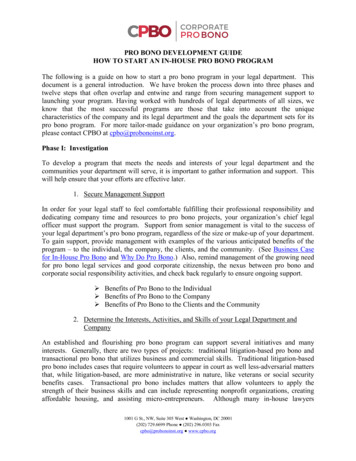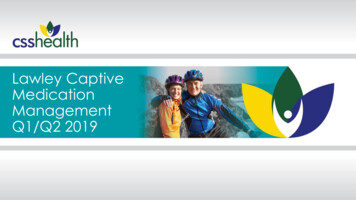
Transcription
HIGHLIGHTS OF PRESCRIBING INFORMATIONThese highlights do not include all the information needed to use PROVIGIL safelyand effectively. See full prescribing information for PROVIGIL.PROVIGIL (modafinil) tablets, for oral use, C-IVInitial U.S. Approval: 1998INDICATIONS AND USAGEPROVIGIL is indicated to improve wakefulness in adult patients with excessivesleepiness associated with narcolepsy, obstructive sleep apnea (OSA), or shift workdisorder (SWD). (1)Limitations of UseIn OSA, PROVIGIL is indicated to treat excessive sleepiness and not as treatment forthe underlying obstruction.DOSAGE AND ADMINISTRATIONThe recommended dosage of PROVIGIL for each indication is as follows: Narcolepsy or OSA: 200 mg once a day in the morning. (2.1) SWD: 200 mg once a day, taken approximately one hour prior to start of the workshift. (2.2) Severe Hepatic Impairment: reduce dose to half the recommended dose. (2.3, 12.3) Geriatric Patients: consider lower dose. (2.4, 12.3)DOSAGE FORMS AND STRENGTHSTablets: 100 mg and 200 mg. (3)CONTRAINDICATIONSPROVIGIL is contraindicated in patients with known hypersensitivity to modafinil orarmodafinil. (4)PROVIGIL (modafinil) tablets [C-IV]WARNINGS AND PRECAUTIONS Serious Rash, including Stevens-Johnson Syndrome: Discontinue PROVIGIL atthe first sign of rash, unless the rash is clearly not drug-related. (5.1) Angioedema and Anaphylaxis Reactions: If suspected, discontinue PROVIGIL. (5.2) Multi-organ Hypersensitivity Reactions: If suspected, discontinue PROVIGIL. (5.3) Persistent Sleepiness: Assess patients frequently for degree of sleepiness and, ifappropriate, advise patients to avoid driving or engaging in any other potentiallydangerous activity. (5.4) Psychiatric Symptoms: Use caution in patients with a history of psychosis, depression,or mania. Consider discontinuing PROVIGIL if psychiatric symptoms develop. (5.5) Known Cardiovascular Disease: Consider increased monitoring. (5.7)ADVERSE REACTIONSMost common adverse reactions ( 5%): headache, nausea, nervousness, rhinitis,diarrhea, back pain, anxiety, insomnia, dizziness, and dyspepsia. (6.1)To report SUSPECTED ADVERSE REACTIONS, contact Teva Pharmaceuticals at1-888-483-8279 or FDA at 1-800-FDA-1088 or www.fda.gov/medwatch.DRUG INTERACTIONS Steroidal contraceptives (e.g., ethinyl estradiol): Use alternative or concomitantmethods of contraception while taking PROVIGIL and for one month after discontinuation of PROVIGIL treatment. (7) Cyclosporine: Blood concentrations of cyclosporine may be reduced. (7) CYP2C19 substrates, such as omeprazole, phenytoin, and diazepam: Exposure ofthese medications may be increased. (7)USE IN SPECIFIC POPULATIONSPregnancy: Based on animal data, may cause fetal harm. (8.1)See 17 for PATIENT COUNSELING INFORMATION and Medication Guide.Revised: 11/2018FULL PRESCRIBING INFORMATION: CONTENTS*1 INDICATIONS AND USAGE2 DOSAGE AND ADMINISTRATION2.1 Dosage in Narcolepsy and Obstructive Sleep Apnea (OSA)2.2 Dosage in Shift Work Disorder (SWD)2.3 Dosage Modifications in Patients with Severe Hepatic Impairment2.4 Use in Geriatric Patients3 DOSAGE FORMS AND STRENGTHS4 CONTRAINDICATIONS5 WARNINGS AND PRECAUTIONS5.1 Serious Rash, including Stevens-Johnson Syndrome5.2 Angioedema and Anaphylaxis Reactions5.3 Multi-organ Hypersensitivity Reactions5.4 Persistent Sleepiness5.5 Psychiatric Symptoms5.6 Effects on Ability to Drive and Use Machinery5.7 Cardiovascular Events6 ADVERSE REACTIONS6.1 Clinical Trials Experience6.2 Postmarketing Experience7 DRUG INTERACTIONS8 USE IN SPECIFIC POPULATIONS8.1 Pregnancy8.3 Nursing Mothers8.4 Pediatric Use8.5 Geriatric Use8.6 Hepatic Impairment9 DRUG ABUSE AND DEPENDENCE9.1 Controlled Substance9.2 Abuse9.3 Dependence10 OVERDOSAGE11 DESCRIPTION12 CLINICAL PHARMACOLOGY12.1 Mechanism of Action12.3 Pharmacokinetics13 NONCLINICAL TOXICOLOGY13.1 Carcinogenesis, Mutagenesis, Impairment of Fertility14 CLINICAL STUDIES14.1 Narcolepsy14.2 Obstructive Sleep Apnea (OSA)14.3 Shift Work Disorder (SWD)16 HOW SUPPLIED/STORAGE AND HANDLING16.1 How Supplied16.2 Storage17 PATIENT COUNSELING INFORMATIONFULL PRESCRIBING INFORMATION1INDICATIONS AND USAGEPROVIGIL is indicated to improve wakefulness in adult patients with excessivesleepiness associated with narcolepsy, obstructive sleep apnea (OSA), or shift workdisorder (SWD).Limitations of UseIn OSA, PROVIGIL is indicated to treat excessive sleepiness and not as treatmentfor the underlying obstruction. If continuous positive airway pressure (CPAP) is thetreatment of choice for a patient, a maximal effort to treat with CPAP for an adequateperiod of time should be made prior to initiating and during treatment with PROVIGILfor excessive sleepiness.2DOSAGE AND ADMINISTRATION2.1Dosage in Narcolepsy and Obstructive Sleep Apnea (OSA)The recommended dosage of PROVIGIL for patients with narcolepsy or OSA is 200 mgtaken orally once a day as a single dose in the morning.Doses up to 400 mg/day, given as a single dose, have been well tolerated, but thereis no consistent evidence that this dose confers additional benefit beyond that of the200 mg/day dose [see Clinical Pharmacology (12.3) and Clinical Studies (14.1, 14.2)].2.2Dosage in Shift Work Disorder (SWD)The recommended dosage of PROVIGIL for patients with SWD is 200 mg taken orallyonce a day as a single dose approximately 1 hour prior to the start of their work shift.2.3Dosage Modifications in Patients with Severe Hepatic ImpairmentIn patients with severe hepatic impairment, the dosage of PROVIGIL should bereduced to one-half of that recommended for patients with normal hepatic function[see Use in Specific Populations (8.6) and Clinical Pharmacology (12.3)].2.4Use in Geriatric PatientsConsideration should be given to the use of lower doses and close monitoring ingeriatric patients [see Use in Specific Populations (8.5)].3DOSAGE FORMS AND STRENGTHS 100 mg – capsule-shaped, white to off white, tablet, debossed with “PROVIGIL”on one side and “100 MG” on the other. 200 mg – capsule-shaped, white to off white, scored, tablet, debossed with“PROVIGIL” on one side and “200 MG” on the other.4CONTRAINDICATIONSPROVIGIL is contraindicated in patients with known hypersensitivity to modafinil orarmodafinil or its inactive ingredients [see Warnings and Precautions (5.1, 5.2, 5.3)].5WARNINGS AND PRECAUTIONS5.1Serious Rash, including Stevens-Johnson SyndromeSerious rash requiring hospitalization and discontinuation of treatment has beenreported in association with the use of modafinil.In clinical trials of modafinil, the incidence of rash resulting in discontinuation wasapproximately 0.8% (13 per 1,585) in pediatric patients (age 17 years); theserashes included 1 case of possible Stevens-Johnson Syndrome (SJS) and 1 case ofapparent multi-organ hypersensitivity reaction. Several of the cases were associatedwith fever and other abnormalities (e.g., vomiting, leukopenia). The median time torash that resulted in discontinuation was 13 days. No such cases were observedamong 380 pediatric patients who received placebo. PROVIGIL is not approved foruse in pediatric patients for any indication [see Use in Specific Populations (8.4)].Rare cases of serious or life-threatening rash, including SJS, Toxic EpidermalNecrolysis (TEN), and Drug Rash with Eosinophilia and Systemic Symptoms (DRESS)*Sections or subsections omitted from the full prescribing information are not listed.1
PROVIGIL (modafinil) tablets [C-IV]PROVIGIL (modafinil) tablets [C-IV]have been reported in adults and children in worldwide postmarketing experience.The reporting rate of TEN and SJS associated with modafinil use, which is generallyaccepted to be an underestimate due to underreporting, exceeds the backgroundincidence rate. Estimates of the background incidence rate for these serious skinreactions in the general population range between 1 to 2 cases per million-person years.There are no factors that are known to predict the risk of occurrence or the severityof rash associated with PROVIGIL. Nearly all cases of serious rash associated withmodafinil occurred within 1 to 5 weeks after treatment initiation. However, isolatedcases have been reported after prolonged treatment (e.g., 3 months). Accordingly,duration of therapy cannot be relied upon as a means to predict the potential riskheralded by the first appearance of a rash.Although benign rashes also occur with PROVIGIL, it is not possible to reliably predictwhich rashes will prove to be serious. Accordingly, PROVIGIL should be discontinuedat the first sign of rash, unless the rash is clearly not drug-related. Discontinuationof treatment may not prevent a rash from becoming life-threatening or permanentlydisabling or disfiguring.5.2Angioedema and Anaphylaxis ReactionsAngioedema and hypersensitivity (with rash, dysphagia, and bronchospasm), wereobserved in patients treated with armodafinil, the R enantiomer of modafinil (whichis the racemic mixture). No such cases were observed in modafinil clinical trials.However, angioedema has been reported in postmarketing experience with modafinil.Patients should be advised to discontinue therapy and immediately report to theirphysician any signs or symptoms suggesting angioedema or anaphylaxis (e.g., swellingof face, eyes, lips, tongue or larynx; difficulty in swallowing or breathing; hoarseness).5.3Multi-organ Hypersensitivity ReactionsMulti-organ hypersensitivity reactions, including at least one fatality in postmarketingexperience, have occurred in close temporal association (median time to detection13 days: range 4-33) to the initiation of modafinil.Although there have been a limited number of reports, multi-organ hypersensitivityreactions may result in hospitalization or be life-threatening. There are no factorsthat are known to predict the risk of occurrence or the severity of multi-organhypersensitivity reactions. Signs and symptoms of this disorder were diverse;however, patients typically, although not exclusively, presented with fever and rashassociated with other organ system involvement. Other associated manifestationsincluded myocarditis, hepatitis, liver function test abnormalities, hematologicalabnormalities (e.g., eosinophilia, leukopenia, thrombocytopenia), pruritus, and asthenia.Because multi-organ hypersensitivity is variable in its expression, other organ systemsymptoms and signs, not noted here, may occur.If a multi-organ hypersensitivity reaction is suspected, PROVIGIL should be discontinued.Although there are no case reports to indicate cross-sensitivity with other drugsthat produce this syndrome, the experience with drugs associated with multi-organhypersensitivity would indicate this to be a possibility.5.4Persistent SleepinessPatients with abnormal levels of sleepiness who take PROVIGIL should be advisedthat their level of wakefulness may not return to normal. Patients with excessivesleepiness, including those taking PROVIGIL, should be frequently reassessed fortheir degree of sleepiness and, if appropriate, advised to avoid driving or any otherpotentially dangerous activity. Prescribers should also be aware that patients may notacknowledge sleepiness or drowsiness until directly questioned about drowsiness orsleepiness during specific activities.5.5Psychiatric SymptomsPsychiatric adverse reactions have been reported in patients treated with modafinil.In the adult PROVIGIL controlled trials, psychiatric symptoms resulting in treatmentdiscontinuation (at a frequency 0.3%) and reported more often in patients treated withPROVIGIL compared to those treated with placebo were anxiety (1%), nervousness(1%), insomnia ( 1%), confusion ( 1%), agitation ( 1%), and depression ( 1%).Postmarketing adverse reactions associated with the use of modafinil have includedmania, delusions, hallucinations, suicidal ideation, and aggression, some resultingin hospitalization. Many, but not all, patients had a prior psychiatric history. Onehealthy male volunteer developed ideas of reference, paranoid delusions, andauditory hallucinations in association with multiple daily 600 mg doses of PROVIGIL(three times the recommended dose) and sleep deprivation. There was no evidenceof psychosis 36 hours after drug discontinuation.Caution should be exercised when PROVIGIL is given to patients with a history ofpsychosis, depression, or mania. Consideration should be given to the possibleemergence or exacerbation of psychiatric symptoms in patients treated with PROVIGIL.If psychiatric symptoms develop in association with PROVIGIL administration,consider discontinuing PROVIGIL.5.6Effects on Ability to Drive and Use MachineryAlthough PROVIGIL has not been shown to produce functional impairment, any drugaffecting the CNS may alter judgment, thinking or motor skills. Patients should becautioned about operating an automobile or other hazardous machinery until it isreasonably certain that PROVIGIL therapy will not adversely affect their ability toengage in such activities.5.7Cardiovascular EventsIn modafinil clinical studies, cardiovascular adverse reactions, including chest pain,palpitations, dyspnea, and transient ischemic T-wave changes on ECG occurred inthree subjects in association with mitral valve prolapse or left ventricular hypertrophy.In a Canadian clinical trial, a 35 year old obese narcoleptic male with a prior historyof syncopal episodes experienced a 9-second episode of asystole after 27 days ofmodafinil treatment (300 mg/day in divided doses). PROVIGIL is not recommendedin patients with a history of left ventricular hypertrophy or in patients with mitral valveprolapse who have experienced the mitral valve prolapse syndrome when previouslyreceiving CNS stimulants. Findings suggestive of mitral valve prolapse syndromeinclude but are not limited to ischemic ECG changes, chest pain, or arrhythmia. If newonset of any of these findings occurs, consider cardiac evaluation. Consider increasedmonitoring in patients with a recent history of myocardial infarction or unstable angina.Blood pressure monitoring in short term ( 3 months) controlled trials showed noclinically significant changes in mean systolic and diastolic blood pressure in patientsreceiving PROVIGIL as compared to placebo. However, a retrospective analysis of theuse of antihypertensive medication in these studies showed that a greater proportionof patients on PROVIGIL required new or increased use of antihypertensivemedications (2.4%) compared to patients on placebo (0.7%). The differential usewas slightly larger when only studies in OSA were included, with 3.4% of patients onPROVIGIL and 1.1% of patients on placebo requiring such alterations in the use ofantihypertensive medication. Increased monitoring of heart rate and blood pressuremay be appropriate in patients on PROVIGIL. Caution should be exercised whenprescribing PROVIGIL to patients with known cardiovascular disease.6ADVERSE REACTIONSThe following serious adverse reactions are described elsewhere in the labeling: Serious Rash, including Stevens-Johnson Syndrome [see Warnings and Precautions (5.1)] Angioedema and Anaphylaxis Reactions [see Warnings and Precautions (5.2)] Multi-organ Hypersensitivity Reactions [see Warnings and Precautions (5.3)] Persistent Sleepiness [see Warnings and Precautions (5.4)] Psychiatric Symptoms [see Warnings and Precautions (5.5)] Effects on Ability to Drive and Use Machinery [see Warnings and Precautions (5.6)] Cardiovascular Events [see Warnings and Precautions (5.7)]6.1Clinical Trials ExperienceBecause clinical trials are conducted under widely varying conditions, adverse reactionrates observed in the clinical trials of a drug cannot be directly compared to rates inthe clinical trials of another drug and may not reflect the rates observed in practice.PROVIGIL has been evaluated for safety in over 3,500 patients, of whom more than2,000 patients with excessive sleepiness associated with OSA, SWD, and narcolepsy.Most Common Adverse ReactionsIn placebo-controlled clinical trials, the most common adverse reactions ( 5%)associated with the use of PROVIGIL more frequently than placebo-treated patientswere headache, nausea, nervousness, rhinitis, diarrhea, back pain, anxiety, insomnia,dizziness, and dyspepsia. The adverse reaction profile was similar across these studies.Table 1 presents the adverse reactions that occurred at a rate of 1% or more andwere more frequent in PROVIGIL-treated patients than in placebo-treated patients inthe placebo-controlled clinical trials.Table 1. Adverse Reactions in Pooled Placebo-Controlled Trials* in Narcolepsy,OSA, and SWDPlaceboPROVIGIL(%)(%)(n 567)(n Back omnia14Anorexia24Dry Mouth24Pharyngitis13Chest Pain13Hypertension12Abnormal Liver n01Abnormal inesia01Edema01Emotional erkinesia01Hypertoniacontinued2
PROVIGIL (modafinil) tablets [C-IV]PROVIGIL (modafinil) tablets [C-IV]rats (modafinil, armodafinil) and rabbits (modafinil), developmental toxicity wasobserved at clinically relevant plasma exposures. PROVIGIL should be used duringpregnancy only if the potential benefit justifies the potential risk to the fetus.Modafinil (50, 100, or 200 mg/kg/day) administered orally to pregnant rats throughoutorganogenesis caused, in the absence of maternal toxicity, an increase in resorptionsand an increased incidence of visceral and skeletal variations in the offspring at thehighest dose tested. The higher no-effect dose for embryofetal developmental toxicityin rats (100 mg/kg/day) was associated with a plasma modafinil AUC less than that inhumans at the recommended human dose (RHD) of PROVIGIL (200 mg/day). However,in a subsequent study of up to 480 mg/kg/day of modafinil, no adverse effects onembryofetal development were observed. Oral administration of armodafinil (60, 200,or 600 mg/kg/day) to pregnant rats throughout organogenesis resulted in increasedincidences of fetal visceral and skeletal variations and decreased fetal body weight atthe highest dose tested. The highest no-effect dose for embryofetal developmentaltoxicity in rats (200 mg/kg/day) was associated with a plasma armodafinil AUC lessthan that in humans at the RHD of PROVIGIL.Modafinil administered orally to pregnant rabbits throughout organogenesis at dosesof up to 100 mg/kg/day had no effect on embryofetal development; however, thedoses used were too low to adequately assess the effects of modafinil on embryofetaldevelopment. In a subsequent developmental toxicity study evaluating doses of45, 90, and 180 mg/kg/day in pregnant rabbits, the incidences of fetal structuralalterations and embryofetal death were increased at the highest dose. The highestno-effect dose for developmental toxicity (100 mg/kg/day) was associated with aplasma modafinil AUC similar to that in humans at the RHD of PROVIGIL.Modafinil administration to rats throughout gestation and lactation at oral doses of upto 200 mg/kg/day resulted in decreased viability in the offspring at doses greater than20 mg/kg/day, a dose resulting in a plasma modafinil AUC less than that in humansat the RHD of PROVIGIL. No effects on postnatal developmental and neurobehavioralparameters were observed in surviving offspring.Pregnancy RegistryA pregnancy registry has been established to collect information on the pregnancyoutcomes of women exposed to PROVIGIL. Healthcare providers are encouraged toregister pregnant patients, or pregnant women may enroll themselves in the registryby calling 1-866-404-4106 (toll free).8.3Nursing MothersIt is not known whether modafinil or its metabolites are excreted in human milk.Because many drugs are excreted in human milk, caution should be exercised whenPROVIGIL is administered to a nursing woman.8.4Pediatric UseSafety and effectiveness in pediatric patients have not been established. PROVIGIL isnot approved in this population for any indication.Serious skin rashes, including erythema multiforme major (EMM) and StevensJohnson Syndrome (SJS) have been associated with modafinil use in pediatric patients[see Warnings and Precautions (5.1)].In a controlled 6-week study, 165 pediatric patients (aged 5-17 years) with narcolepsywere treated with modafinil (n 123), or placebo (n 42). There were no statisticallysignificant differences favoring modafinil over placebo in prolonging sleep latencyas measured by MSLT, or in perceptions of sleepiness as determined by the clinicalglobal impression-clinician scale (CGI-C).In the controlled and open-label clinical studies, treatment emergent adverse reactionsof the psychiatric and nervous system included Tourette’s syndrome, insomnia,hostility, increased cataplexy, increased hypnagogic hallucinations, and suicidalideation. Transient leukopenia, which resolved without medical intervention, was alsoobserved. In the controlled clinical study, 3 of 38 girls, ages 12 or older, treated withmodafinil experienced dysmenorrhea compared to 0 of 10 girls who received placebo.There were three 7 to 9 week, double-blind, placebo-controlled, parallel group studiesin children and adolescents (aged 6-17 years) with Attention-Deficit HyperactivityDisorder (ADHD). Two of the studies were flexible-dose studies (up to 425 mg/day),and the third was a fixed-dose study (340 mg/day for patients 30 kg and 425 mg/dayfor patients 30 kg). Although these studies showed statistically significant differencesfavoring modafinil over placebo in reducing ADHD symptoms as measured by theADHD-RS (school version), there were 3 cases of serious rash including one case ofpossible SJS among 933 patients exposed to modafinil in this program. Modafinil isnot approved for use in treating ADHD.8.5Geriatric UseIn clinical trials, experience in a limited number of modafinil-treated patients whowere greater than 65 years of age showed an incidence of adverse reactions similarto other age groups. In elderly patients, elimination of modafinil and its metabolitesmay be reduced as a consequence of aging. Therefore, consideration should be givento the use of lower doses and close monitoring in this population [see Dosage andAdministration (2.4) and Clinical Pharmacology (12.3)].8.6Hepatic ImpairmentIn patients with severe hepatic impairment, the dose of PROVIGIL should be reducedto one-half of that recommended for patients with normal hepatic function [seeDosage and Administration (2.3) and Clinical Pharmacology (12.3)].9DRUG ABUSE AND DEPENDENCE9.1Controlled SubstancePROVIGIL contains modafinil, a Schedule IV controlled substance.9.2AbuseIn humans, modafinil produces psychoactive and euphoric effects, alterations in mood,perception, thinking, and feelings typical of other CNS stimulants. In in vitro bindingstudies, modafinil binds to the dopamine reuptake site and causes an increase inPlaceboPROVIGIL(%)(%)(n 567)(n 934)01Mouth Ulcereation01Sweating01Taste Perversion01Thirst01Tremor01Urine Abnormality01Vertigo*Adverse Reactions that occurred in 1% of PROVIGIL-treated patients (either 200,300, or 400 mg once daily) and greater incidence than placeboDose-Dependent Adverse ReactionsIn the placebo-controlled clinical trials which compared doses of 200, 300, and400 mg/day of PROVIGIL and placebo, the following adverse reactions were doserelated: headache and anxiety.Adverse Reactions Resulting in Discontinuation of TreatmentIn placebo-controlled clinical trials, 74 of the 934 patients (8%) who receivedPROVIGIL discontinued due to an adverse reaction compared to 3% of patientsthat received placebo. The most frequent reasons for discontinuation that occurredat a higher rate for PROVIGIL than placebo patients were headache (2%), nausea,anxiety, dizziness, insomnia, chest pain, and nervousness (each 1%).Laboratory AbnormalitiesClinical chemistry, hematology, and urinalysis parameters were monitored in thestudies. Mean plasma levels of gamma glutamyltransferase (GGT) and alkalinephosphatase (AP) were found to be higher following administration of PROVIGIL, butnot placebo. Few patients, however, had GGT or AP elevations outside of the normalrange. Shifts to higher, but not clinically significantly abnormal, GGT and AP valuesappeared to increase with time in the population treated with PROVIGIL in the placebocontrolled clinical trials. No differences were apparent in alanine aminotransferase(ALT), aspartate aminotransferase (AST), total protein, albumin, or total bilirubin.6.2Postmarketing ExperienceThe following adverse reactions have been identified during post approval use ofPROVIGIL. Because these reactions are reported voluntarily from a populationof uncertain size, it is not always possible to reliably estimate their frequency orestablish a causal relationship to drug exposure.Cardiovascular: StrokeHematologic: agranulocytosisPsychiatric disorders: psychomotor hyperactivity7DRUG INTERACTIONSEffects of PROVIGIL on CYP3A4/5 SubstratesThe clearance of drugs that are substrates for CYP3A4/5 (e.g., steroidal contraceptives,cyclosporine, midazolam, and triazolam) may be increased by PROVIGIL via inductionof metabolic enzymes, which results in lower systemic exposure. Dosage adjustmentof these drugs should be considered when these drugs are used concomitantly withPROVIGIL [see Clinical Pharmacology (12.3)].The effectiveness of steroidal contraceptives may be reduced when used with PROVIGILand for one month after discontinuation of therapy. Alternative or concomitant methodsof contraception are recommended for patients taking steroidal contraceptives (e.g.,ethinyl estradiol) when treated concomitantly with PROVIGIL and for one month afterdiscontinuation of PROVIGIL treatment.Blood levels of cyclosporine may be reduced when used with PROVIGIL. Monitoringof circulating cyclosporine concentrations and appropriate dosage adjustment forcyclosporine should be considered when used concomitantly with PROVIGIL.Effects of PROVIGIL on CYP2C19 SubstratesElimination of drugs that are substrates for CYP2C19 (e.g., phenytoin, diazepam,propranolol, omeprazole, and clomipramine) may be prolonged by PROVIGIL viainhibition of metabolic enzymes, with resultant higher systemic exposure. In individualsdeficient in the CYP2D6 enzyme, the levels of CYP2D6 substrates which have ancillaryroutes of elimination through CYP2C19, such as tricyclic antidepressants andselective serotonin reuptake inhibitors, may be increased by co-administration ofPROVIGIL. Dose adjustments of these drugs and other drugs that are substrates forCYP2C19 may be necessary when used concomitantly with PROVIGIL [see ClinicalPharmacology (12.3)].WarfarinMore frequent monitoring of prothrombin times/INR should be considered wheneverPROVIGIL is coadministered with warfarin [see Clinical Pharmacology (12.3)].Monoamine Oxidase (MAO) InhibitorsCaution should be used when concomitantly administering MAO inhibitors andPROVIGIL.8USE IN SPECIFIC POPULATIONS8.1PregnancyPregnancy Category CThere are no adequate and well-controlled studies of modafinil in pregnant women.Intrauterine growth restriction and spontaneous abortion have been reported inassociation with modafinil (a mixture of R- and S-modafinil) and armodafinil (theR-enantiomer of modafinil). Although the pharmacology of modafinil is not identicalto that of the sympathomimetic amines, it does share some pharmacologic propertieswith this class. Certain of these drugs have been associated with intrauterine growthrestriction and spontaneous abortions. Whether the cases reported with modafinilare drug-related is unknown. In studies of modafinil and armodafinil conducted in3
PROVIGIL (modafinil) tablets [C-IV]PROVIGIL (modafinil) tablets [C-IV]extracellular dopamine, but no increase in dopamine release. Modafinil is reinforcing,as evidenced by its self-administration in monkeys previously trained to self-administercocaine. In some studies, modafinil was also partially discriminated as stimulant-like.Physicians should follow patients closely, especially those with a history of drugand/or stimulant (e.g., methylphenidate, amphetamine, or cocaine) abuse. Patientsshould be observed for signs of misuse or abuse (e.g., incrementation of doses ordrug-seeking behavior).The abuse potential of modafinil (200, 400, and 800 mg) was assessed relative tomethylphenidate (45 and 90 mg) in an inpatient study in individuals experiencedwith drugs of abuse. Results from this clinical study demonstrated that modafinilproduced psychoactive and euphoric effects and feelings consistent with otherscheduled CNS stimulants (methylphenidate).9.3DependenceIn one placebo-controlled clinical trial, the effects of modafinil withdrawal weremonitored following 9 weeks of modafinil use. There were no reported withdrawalsymptoms with modafinil during 14 days of observation, although sleepiness returnedin narcoleptic patients.10OVERDOSAGEIn clinical trials, a total of 151 protocol-specified doses ranging from 1000 to1600 mg/day (5 to 8 times the recommended daily dose of PROVIGIL) have beenadministered to 32 subjects, including 13 subjects who received doses of 1000or 1200 mg/day for 7 to 21 consecutive days. In addition, several intentional acuteoverdoses occurred; the two largest being 4500 mg and 4000 mg taken by two subjectsparticipating in foreign depression studies. None of these study subjects experiencedany unexpected or life-threatening effects. Adverse reactions that were reported at thesedoses included excitation or agitation, insomnia, and slight or moderate elevationsin hemodynamic parameters. Other observed high-dose effects in clinical studieshave included anxiety, irritability, aggressiveness, confusion, nervousness, tremor,palpitations, sleep disturbances, nausea, diarrhea, and decreased prothrombin time.From postmarketing experience, there have been reports of fatal overdoses involvingmodafinil alone or in c
of treatment may not prevent a rash from becoming life-threatening or permanently disabling or disfiguring. 5.2 Angioedema and Anaphylaxis Reactions Angioedema and hypersensitivity (with rash, dysphagia, and bronchospasm), were observed in patients treated with armodafinil, the R enantiomer of modafinil (which is the racemic mixture).










